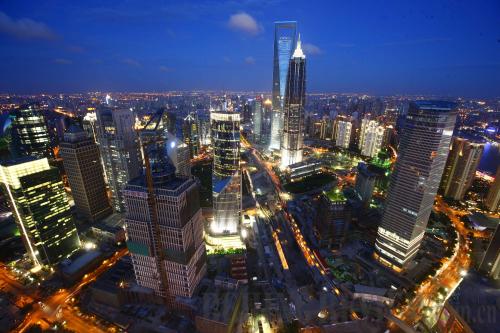|
 |
|
BUSTLING PUDONG: Pudong, located on the east bank of the Huangpu River, has become Shanghai's financial hub (XINHUA) |
Tianzifang is located on Lane 210, Taikang Road. While once a cluster of street factories, dilapidated warehouses and ordinary people's homes, the area has been transformed into a SOHO style district.
Artists from all over the world have set up their studios, cafés, bars and restaurants here giving the area an international feel. With an area of 20,000 square meters and more than 100 visual art, industrial art and interior design houses, the former 1930s street factories have become studios for American, Japanese, Belgian and French designers and have earned the name "Shanghai SOHO."
In the 1930s, many people took refuge in the foreign concession areas—including what would become Tianzifang—and built houses combining Western and local architectural styles. Since the gates of the houses are ringed and fixed in stone, they became known as stone gates, or Shikumen.
Visitors looking for a panoramic view of Shanghai, as opposed to the up-close streets of Tianzifang, typically flocked to the Oriental Pearl TV Tower and Jin Mao Tower in the Lujiazui area on the east bank of the Huangpu River.
Now, in Lujiazui, stands the tallest tower on the Chinese mainland—the Shanghai World Financial Center.
Completed in 2008, the Shanghai World Financial Center stands 492 meters tall. The center has observation platforms on the 94th through 100th floors. A suspended observation corridor at a height of 474 meters allows viewers to see the tip of the Oriental Pearl TV Tower, look down on the neighboring Jin Mao Tower and see all the sights along both sides of the Huangpu River. And of course Expo Park can be seen in the distance.
In the 1920s and 30s, Shanghai was a favorite destination among China's northern neighbors, the Russians. The Russian influence on the city can be seen in structures such as the Russian Consulate on the bank of the Huangpu River and the stone sculpture of the great poet Alexander Pushkin on Yueyang Road.
The bust of Alexander Pushkin was first erected on February 10, 1937 by Russian nationals in memory of the 100th anniversary of the poet's death. The sculpture was destroyed in November 1944 during the War of Resistance Against Japanese Aggression (1937-45) and rebuilt in 1947. But in 1966, the bust was destroyed once more during the "cultural revolution" (1966-76). The reform and opening up beginning in 1978 brought a new era of sculpting to the city. A large sum of money was appropriated to promote local sculptural constructions across China, with Shanghai receiving the largest sum. After some deliberation, it was decided the Pushkin monument would be rebuilt. In August 1987, the 150th anniversary of Pushkin's death, the statue was erected for the third time in its original location.
| 